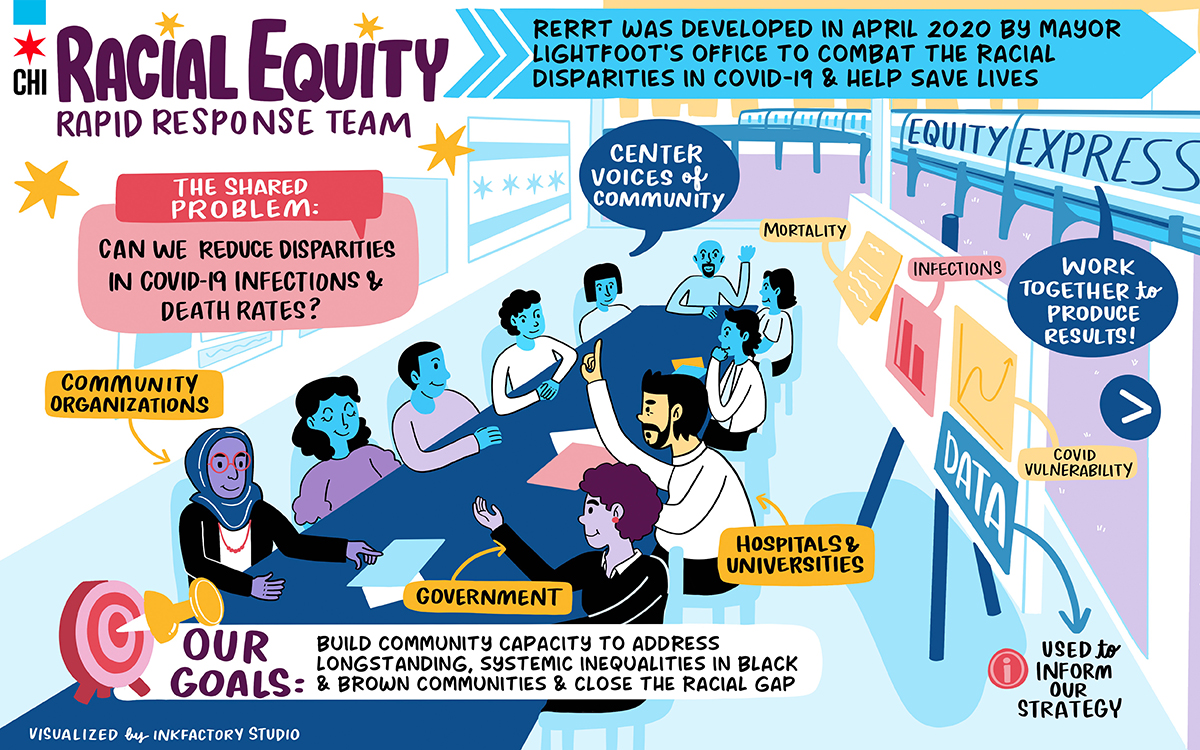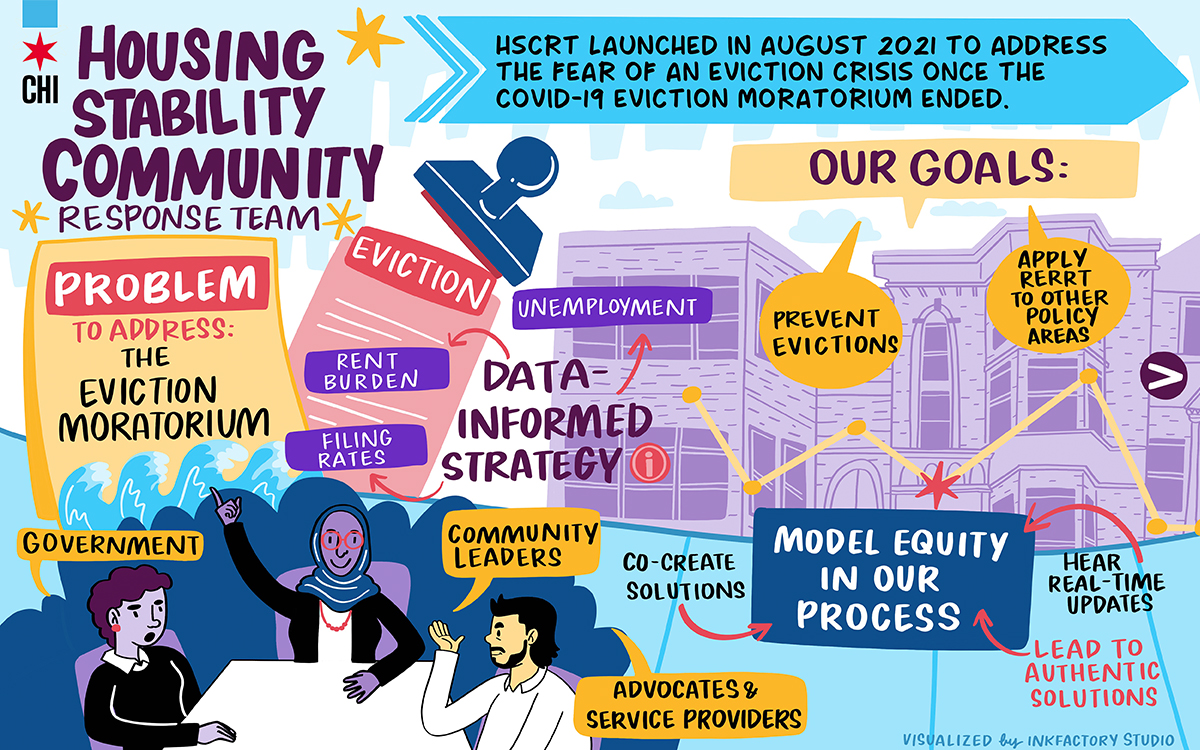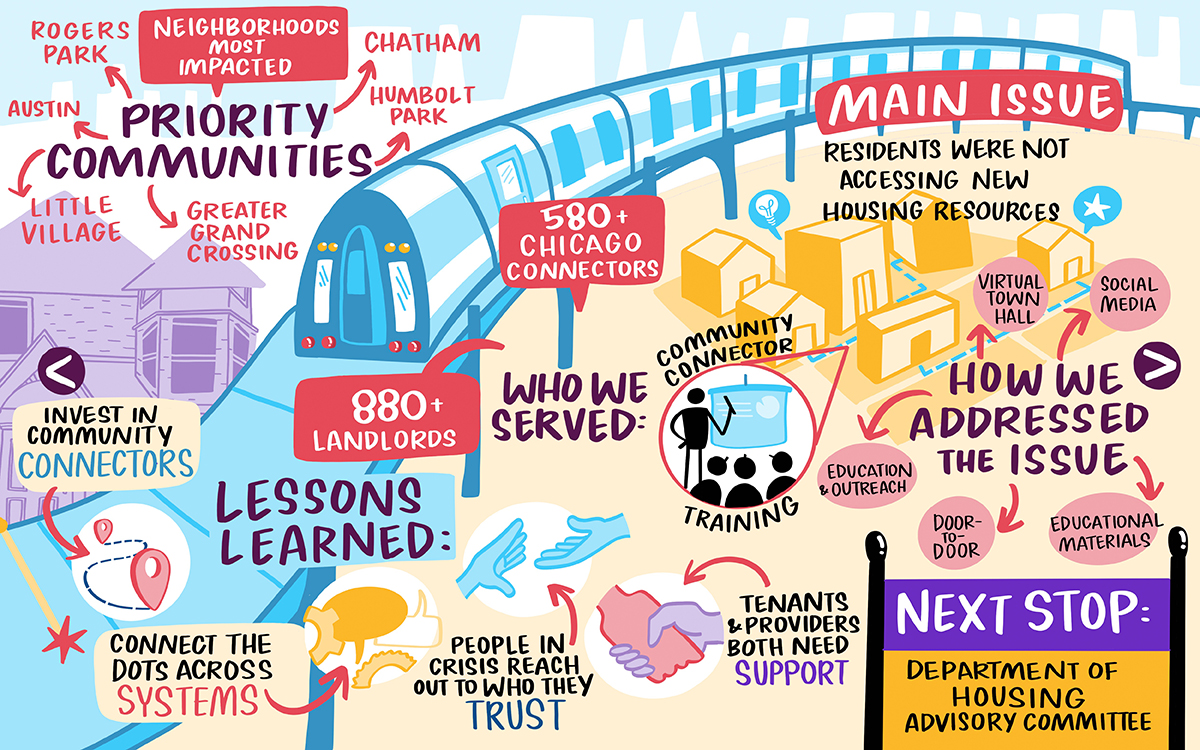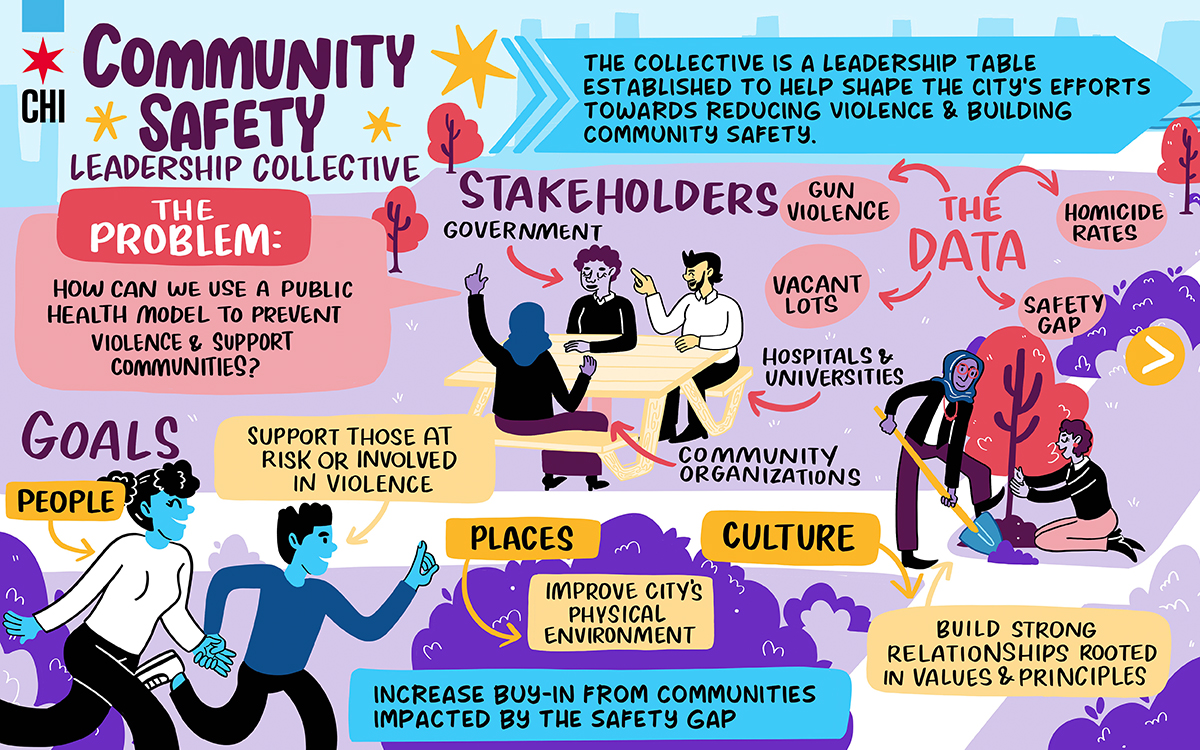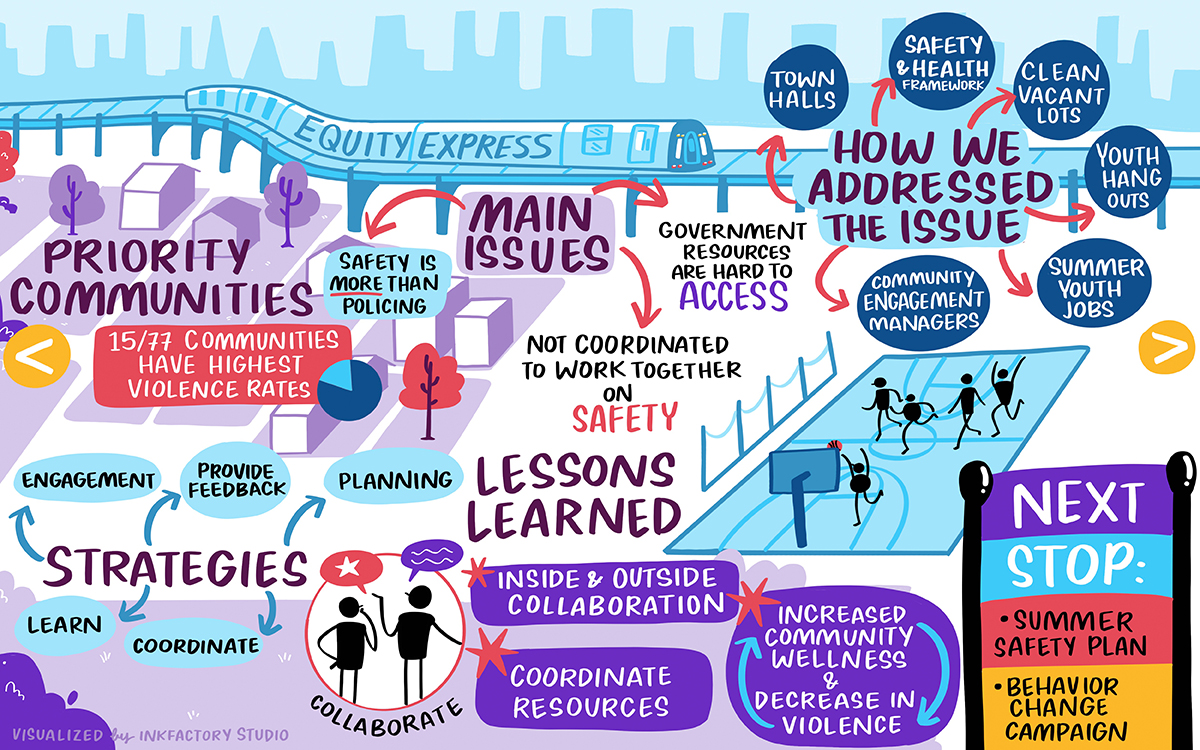Tools & Partnerships
OERJ aims to establish and advance new models of engagement and practice that aim to reduce and eliminate harm and co-create solutions with those most impacted by the problems. Tactically, this leads to three buckets of work:
-
Build capacity of departments/government staff,
-
Shift power to those who are most impacted by a problem
-
Transform policy to support those who need the most support
Below, you will find tools divided into two categories: Internal and External. The former is a list of tools created by the City of Chicago and serve as a foundation to build capacity for equity. The latter is a list of tools that OERJ regularly references and shares with City employees to incorporate equity into their work. All in all, these tools work as a shared guide to further government’s understanding of equity and best practices.
OERJ’s Equity Statement of Principles (ESOP) outlines the office’s vision, guiding principles and overall approach to strengthen our muscle for equity to build a more equitable Chicago. Among our principles is our shared definition of equity that manifests in our work and can be embraced by the entire City of Chicago enterprise.
To learn more, CLICK HERE.
Examining disaggregated data is essential to racial equity analysis. Unfortunately, a lot of City data is not publicly available. OERJ partners with our data colleagues, especially the Chief Technology Officer and the Chicago Digital Services team, to publish as much data as possible while respecting privacy and individual information. OERJ has heavily supported the creation of three dashboards.
Equity Dashboard: City of Chicago's Workforce Diversity
- OERJ developed this equity dashboard to highlight the City’s workforce diversity data and to serve as a tool to support our long-term goals to have the City workforce reflect the population of Chicago. Many departments have goals to increase and cultivate diversity, equity and inclusion in their teams. To view dashboard, click HERE
We Will Chicago Equity Dashboard
- When thinking about impact, we need to look at the population overall and at metrics that indicate overall wellbeing of people who live here. We Will Chicago is a 10-year framework to enhance citywide equity and resiliency and improve Chicagoans' lives, especially individuals impacted by inequities in health, economic stability, neighborhood livability, and other systemic issues. The We Will Chicago Equity Dashboard provides data on key indicators of equity in Chicago across the 8 pillars of the plan. The intent is to transparently display the current equity gaps that will be addressed through the implementation of the plan. The dashboard will also show change over time along the key indicators to help monitor overall progress in closing key disparities. To view the dashboard, click HERE.
There are numerous ways to engage community. Helping our government and community partners understand what sort of engagement they plan to do and why is key to long-term trust-building between community partners and government teams. This spectrum, developed by Rosa Gonzalez at Facilitating Power, is a useful tool to help government teams recognize why community groups may not feel respected (perhaps they are only asking for input after the fact instead of providing a seat at the decision-making table).
“A Racial Equity Impact Assessment (REIA) is a systematic examination of how different racial and ethnic groups will likely be affected by a proposed action or decision” (Race Forward). Government teams can use REIAs when they are analyzing proposed policies, institutional practices, programs, plans and budgetary decisions. REIAs help us think about the results/outcomes of a decision and center the voices of those most impacted by a particular policy program. Ultimately, it helps prevent and reduce institutional racism
The Chicago Department of Housing (DOH) executed and published the City of Chicago’s first Racial Equity Impact Assessment (REIA) in 2021 on the Qualified Allocation Plan. The QAP is a set of instructions to guide Low-Income Housing Tax Credit (LIHTC) developers through the process of acquiring tax credits for producing affordable rental units. LIHTC is DOH’s largest single source of funds for affordable rental units and has been in use since the 1980s. You can see links to both the REIA tool and the DOH QAP below.
Part of OERJ’s Theory of Change is to center voices of community members most impacted by the problem by partnering with trusted community organizations, government leaders, and other stakeholders. The illustrations below capture three major efforts where OERJ convened shared-decision tables to co-create solutions with stakeholders from priority communities. This unique approach to problem-solving shifts decision-making powers from the government to community members. In inviting community members — who undeniably understand their community needs the most — OERJ was able to achieve equitable results that improved outcomes for marginalized communities and opened the door for new learning opportunities and approaches.
RERRT was developed in April 2020 by the Mayor’s Office to combat the racial disparities in COVID-19 and help save lives. COVID-19 was having a disproportionate impact on communities of color; early on over half of individuals dying from COVID-19 were Black and over time Latinx communities had the highest infection rates. There was a need to better support communities of color in light of the structural inequalities that were driving the disparity.
Partners Convened
- Community organizations: West Side United, Greater Auburn Gresham Community Development Corporation, Austin Coming Together, South Shore Works, Enlace, Latinos Progresando, NW Center, and Southwest Organizing Project
- Institutional partners: Rush University Medical Center, Sinai Urban Health Institute, University of Chicago, Advocate Health, University of Illinois Chicago, Lurie Children’s Hospital and Esperanza Health
Lessons Learned
- Work with existing community organizations who already have community trust: The ability to co-create with organizations on the ground is foundational; it is important to build trust in order to do transformational work.
- Work across systems to pair resources together and create more options/opportunities: Collective resources can produce more options and opportunities than any single organization had on its own. This helped us work past constraints.
- Equity requires adaptive leadership: Solutions for communities are not one size fits all; it is important to be able to be iterative and responsive to the needs of those most impacted by the issue.
HSCRT launched in August 2021 to address the fear of an eviction crisis once the COVID-19 eviction moratorium ended. HSCRT strategized as to how we can prevent an eviction crisis in outmost vulnerable communities.
Partners Convened
- Community organizations: Acclivus Inc., Center for Changing Lives, Far South CDC, Latinos Progresando, West Side Health Authority, Zam’s Hope.
- Institutional Partners
- Advocates: Chicago Bar Foundation, Spanish Coalition for Housing, Law Center for Better Housing, Metropolitan Tenants Organization
- Housing Lenders: Community Investment Corporation, Neighborhood Housing Services of Chicago
- Research Institutions: University of Chicago Inclusive Economy Lab
Lessons Learned
- Multiple systems trying to have impact on the same vulnerable populations must work together: Cross-government communication was key to reaching impacted residents.
- People in crisis reach out to who they trust first, not necessarily the experts: Training the trusted messengers in community to better understand the problem and where to go to connect people to resources is important and much needed.
- Tenants and housing providers both need support to stabilize housing: This table helped foster trust among our partners convened for this effort, which led to open dialogue and actionable change.
Modeled from the RERRT, the Collective is a leadership table that helps advise the city’s coordination efforts to provide a comprehensive approach to addressing the root causes of community violence. This work includes working across City departments to implement strategies that connect people to the resources they need to thrive, rebuild the physical environment to be safer and healthier, and foster a culture of community wellness. We wanted to know if using some of the lessons learned from our Covid response can have a positive impact on our approach to violence prevention. Namely, can working with communities to support them in building the resources and assets they need help drive down violence?
Partners Convened
- Community organizations: South Shore Works (Black/Southside), Teamwork Englewood (Black/Southside), ENLACE Chicago (Latinx/Southwest), New Life Centers (Latinx/Southwest), Firehouse Community Arts Center (Black/Westside), Beyond the Ball (Latinx/Southwest), North Lawndale Community Coordinating Council (Black/Westside), Garfield Park Rite to Wellness (Black/Westside), Institute for Non-Violence Chicago (Black/Westside)
- Institutional Partners: Northwestern University, Mt. Sinai Hospital, University of Chicago Crime Lab, University of Chicago Medicine
Lessons Learned
- Coordinating resources around the most impacted communities is essential.
- Violence is a symptom of an unwell community. We can work to build wellness in community.
- Increased community wellness can result in decreased community violence.
.png)
Understanding Co-Governance
OERJ’s work to co-design solutions with communities most impacted is the seed for a larger vision set by Mayor Brandon Johnson’s administration: building a more collaborative government. A co-governance process is a strategy centered around sharing economic and political power that helps ensure that the government is actively working with communities to design and implement policies such that the people who are most harmed by structural racism and our economic system are part of co-creating the solutions. To get here, OERJ is embarking on a journey to co-create a shared definition of co-governance and to build more models that reimagine collaboration between government and community.
To kick off our journey, OERJ and Chicago United for Equity (CUE) hosted a convening for a convesation around co-governance. Click below to learn more.
To drive transformative policy, it is critical to identify and strategize around areas where there is a significant racial gap. The Digital Equity Initiative and Community Wealth Building Initiative are both great models of transformative policy as both strive to disrupt the imbalance of power and catalyze efforts to close disparities. OERJ worked closely with both initiatives.
In November 2021, the Mayor's Office announced the Community Wealth Building initiative, an approach to economic development that promotes the local, democratic, and shared ownership and control of community assets. The Office of Equity and Racial Justice assembled the CWB Advisory Council to ensure that the design and implementation of the CWB strategy was community-led, inclusive, and empowering of those who have been most disenfranchised. It included 20 community leaders and practitioners, including community organizers, researchers, attorneys, funders, technical assistance providers, and more. The advisory council met monthly and helped organize a series of “field trips” for City staff to deepen their knowledge of local CWB models.
This community-centered approach informed the design of the $15M pilot program that is offering grants and technical assistance to various worker cooperatives; limited-equity housing cooperatives; community land trusts; and community investment vehicles.
Watch the video below exploring what this initiative is all about.
Chicago Community Wealth Building from Jenna Pollack on Vimeo.
Want to learn more about Community Wealth Building? CLICK HERE.
In May 2022, the City launched the Chicago Digital Equity Council (DEC). The DEC convened a cross-sector group of community members and organizations most impacted by the digital divide to uncover Chicagoans’ greatest barriers to accessing broadband, devices, and digital skills. The DEC facilitated community conversations and solution design sessions in Chicago’s least connected neighborhoods, leading to the publication of the Chicago Digital Equity Plan, a community-driven roadmap for closing the digital divide. The recommendations in the plan aim to eliminate digital disparities through coalition building, increasing availability of affordable, quality broadband options, equipping community members with devices that meet their needs, and helping residents build the digital skills they need to participate in Chicago’s modern economy.
To learn more, visit Chicago.gov/digitalequity.

